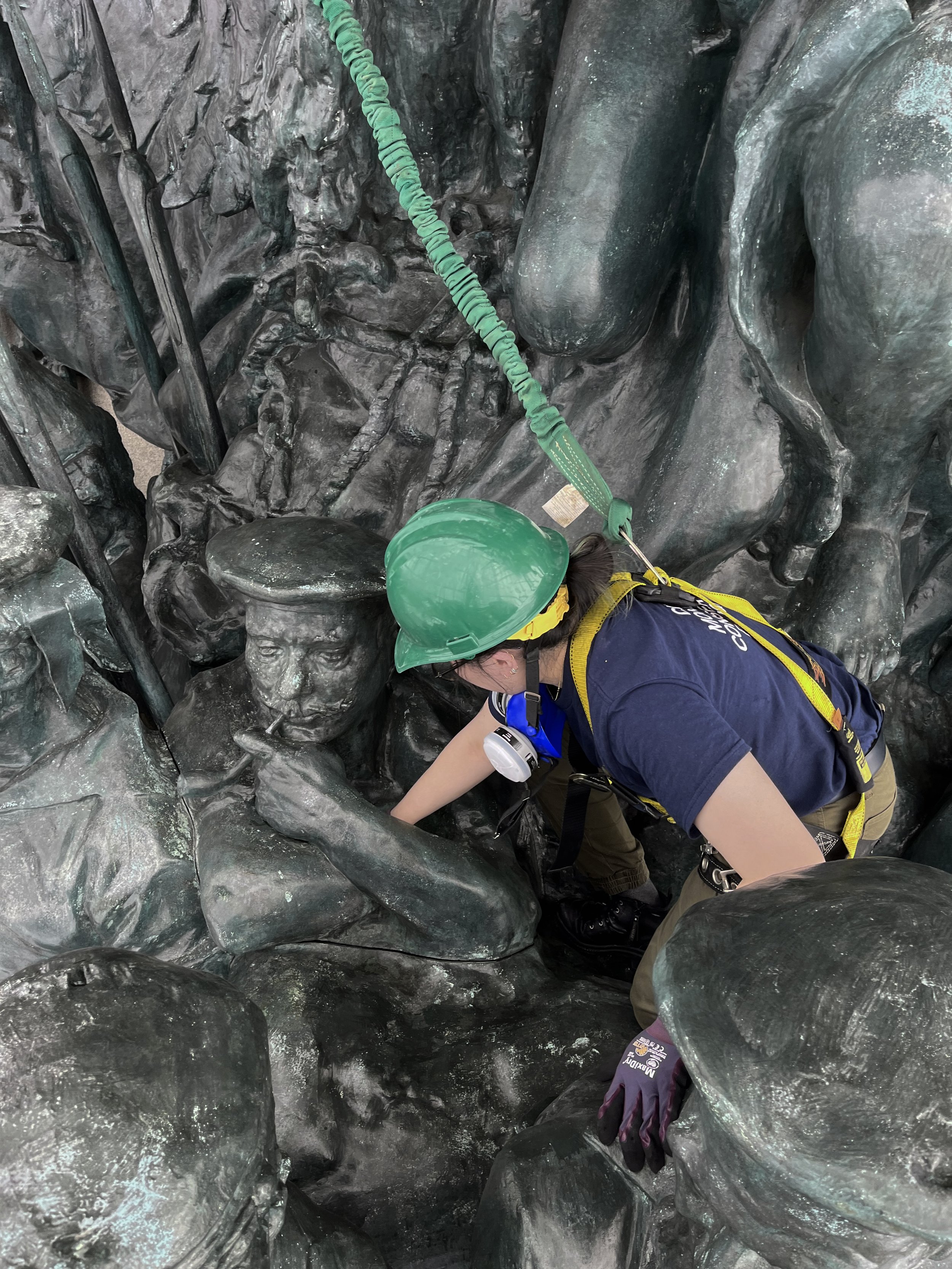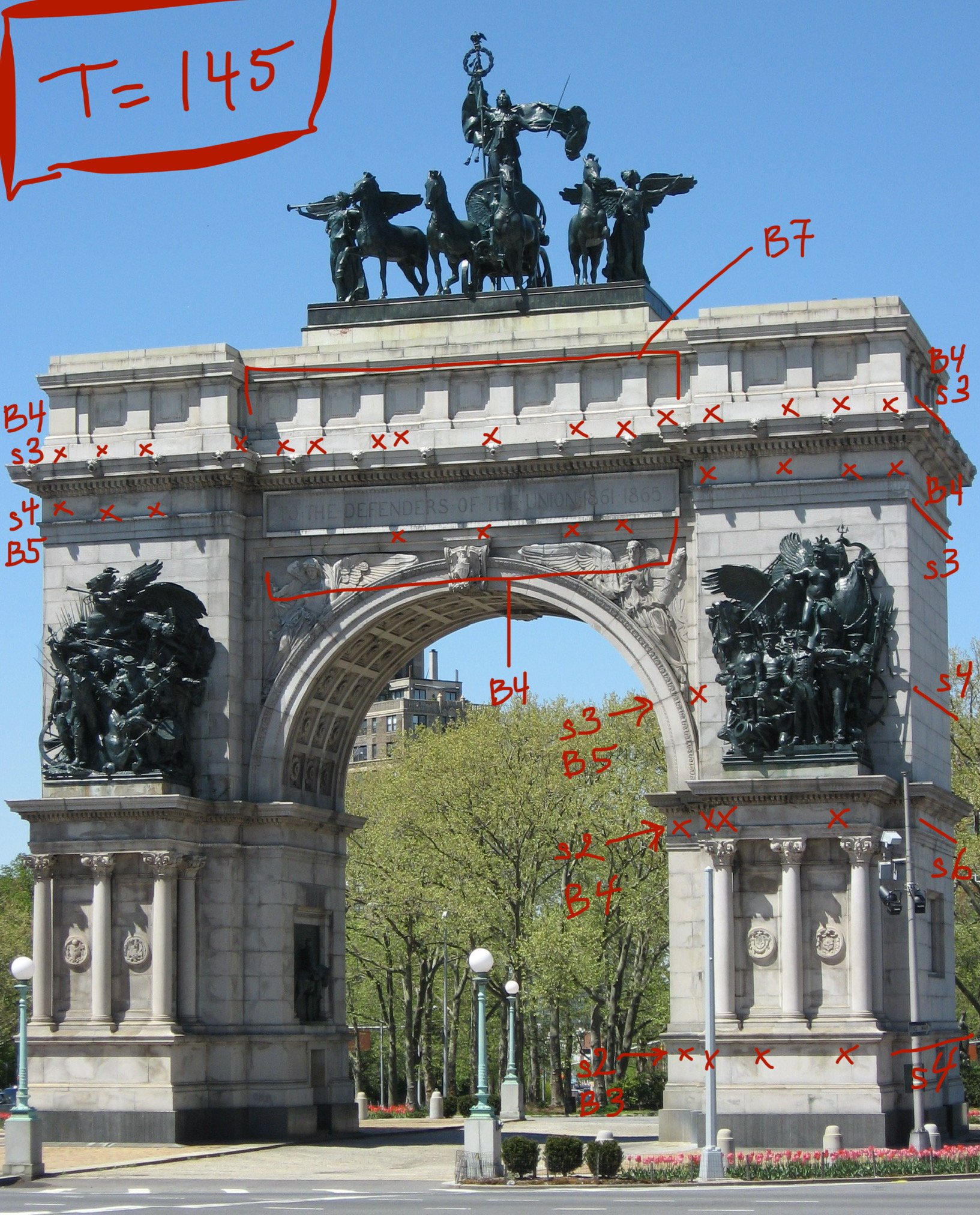Cleaning and lacquering the monumental bronzes of Grand Army Plaza’s Arch
As the Soldiers and Sailors Memorial Arch was an active construction site operated by a private contractor, and undergoing major internal and external renovations, my cohort and I took training courses at the NYC Parks Academy to receive certifications for scaffolding safety and fall protection for aerial lift operations in order to be permitted to work on the treatment of the Arch’s decorative bronzes. Rather than being patinated the deep green we see today, these bronzes had been lacquer-tinted to mimic such a patina, and in areas where the lacquer had failed, oxidation resulted in visually disruptive bright green patches. Additionally, the bronze reliefs decorating the inside legs of the arch had been subject to heavy water run-off filtering down from the damaged roof of the arch and through failed mortar in the stone, resulting in significant limescale that needed to be removed.
As there was not enough time or the right equipment to strip the bronzes of their thick, tinted lacquer coating and patinating them in full, our treatment involved cleaning the statues and reliefs, inpainting the oxidized areas with pigment bound in lacquer, and lacquering the bronzes entirely with a new top coat of clear lacquer (NB: we used Permalac NT Satin, which is a different lacquer from what had been used previously). One of the main challenges of this process was keeping the surface of the metal clean and dry while working with lacquer, as clouds of dust from the grinding of failed mortar would frequently drift over us, and water spilled down from above, which would happen despite our best attempts at effective coordination with the foreman and his team. It was necessary to clean repeatedly section by section as we worked, and to wait out the worse moments. We also had to deal with consistent equipment failure, resulting in our having to use buckets of water to rinse down the statues, and switching from using an HVLP spray gun for the lacquer top coat, to applying it manually with brushes.
An additional complication arose with this project when our supervisor discovered that the contractor had drilled directly into the stone of the arch to install supports for the scaffold, which irreparably damaged the historic stone. One of my fellow interns and I were tasked with discreetly surveying and documenting the damage caused by this process, and I logged the number and placement of holes drilled (a total of 145) on a photo which we then submitted to the department for their records.
It was an arduous task to accomplish this treatment during the hottest days of the summer while wearing respirator masks, hardhats, harnesses, leashes, and goggles, but we were able to finish our work two days ahead of schedule, despite the many issues we encountered.

Old image of the Soldiers and Sailors Memorial Arch, viewed from the front. (Photo: NYC Parks)

The scaffolded Arch. (Photo: Jennifer Kim)

Pressure washing the Sailors. (Photo: Magnus Cleveland)

Mopping up water from washing in recesses of the Sailors. (Photo: Madeline Krol)

Lacquer inpainting on Soldiers. (Photo: NYC Parks)

Lacquer inpainting on the Lincoln relief. (Photo: Kayla Abaza)

Detail of a Soldier's hand and horse bit before lacquer inpainting. (Photo: Jennifer Kim)

Detail of a Soldier's hand and horse bit after lacquer inpainting. (Photo: Jennifer Kim)

Applying a top coat of lacquer on Soldiers. (Photo: Aidan Thomas)

Example of both a support beam bolted into a drilled hole, and a beam extending into full contact against the surface of the stone. (Photo: Jennifer Kim)

Diagram of the holes drilled into the arch for the scaffold. (Photo: Wikipedia, edits by Jennifer Kim)